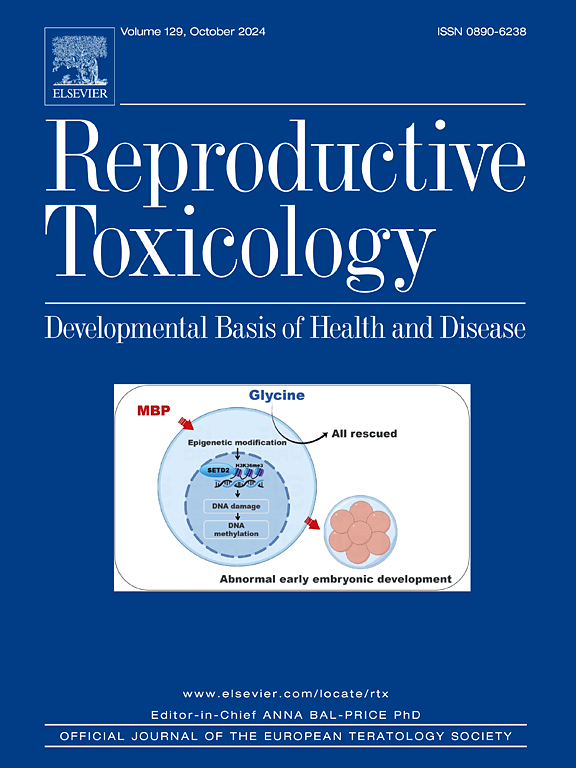Ameliorative effect of curcumin loaded nanoliposomes: A Promising bioactive formulation, against the DBP-induced testicular damage
IF 2.8
4区 医学
Q2 REPRODUCTIVE BIOLOGY
引用次数: 0
Abstract
Plasticizers are widely employed in various applications. Therefore, these products may have an impact on the biological systems of humans and other organisms. Thus, seeking a potent and eco-friendly protective agent becomes a great challenge. The current study investigated the underlying molecular mechanism associated with the protective effect of curcumin-loaded nanoliposomes (CUR nanoliposomes) against DBP-induced testicular damage. A total of twenty-four adult male rats were split up into four groups: the control group, the CUR nanoliposomes-treated group (100 mg/kg/day by oral gavage), the DBP-treated group (500 mg/kg/day by oral gavage), and the last group that received both treatments simultaneously for 60 days. The results showed that DBP exposure induced Leydig cell damage and testicular injury, represented by decreased serum sex hormone levels, downregulation of INSL3 gene expression, elevated testicular LDH, and aberrant sperm rate, as well as pathologically abnormal testicular anatomy. These testicular injuries are associated with redox state imbalance (elevated MDA, reduced CAT activity, and downregulation of Nrf2 and SOD gene expression), elevated apoptosis biomarkers (CASP3 and CASP9), and dysregulation of the PI3K/AKT/mTOR pathway. Co-administration of CUR nanoliposomes succeeded in reversing DBP-induced testicular damage. CUR nanoliposome-induced testicular protection could be attributed to the modulation of the PI3K/AKT/mTOR pathway.
姜黄素负载纳米脂质体的改善作用:一种有前景的生物活性制剂,对抗dbp诱导的睾丸损伤
增塑剂广泛应用于各种应用中。因此,这些产品可能对人类和其他生物的生物系统产生影响。因此,寻找一种有效且环保的保护剂成为一个巨大的挑战。目前的研究探讨了姜黄素纳米脂质体(CUR纳米脂质体)对dbp诱导的睾丸损伤的保护作用的潜在分子机制。将24只成年雄性大鼠分为4组:对照组、CUR纳米脂质体处理组(100 mg/kg/d灌胃)、dbp处理组(500 mg/kg/d灌胃),最后一组同时给予两种处理60 d。结果表明,DBP暴露可引起睾丸间质细胞损伤和睾丸损伤,表现为血清性激素水平降低,INSL3基因表达下调,睾丸LDH升高,精子率异常,睾丸解剖病理异常。这些睾丸损伤与氧化还原状态失衡(MDA升高、CAT活性降低、Nrf2和SOD基因表达下调)、凋亡生物标志物(CASP3和CASP9)升高以及PI3K/AKT/mTOR通路失调有关。同时给药CUR纳米脂质体成功逆转dbp诱导的睾丸损伤。CUR纳米脂质体诱导的睾丸保护可能归因于PI3K/AKT/mTOR通路的调节。
本文章由计算机程序翻译,如有差异,请以英文原文为准。
求助全文
约1分钟内获得全文
求助全文
来源期刊

Reproductive toxicology
生物-毒理学
CiteScore
6.50
自引率
3.00%
发文量
131
审稿时长
45 days
期刊介绍:
Drawing from a large number of disciplines, Reproductive Toxicology publishes timely, original research on the influence of chemical and physical agents on reproduction. Written by and for obstetricians, pediatricians, embryologists, teratologists, geneticists, toxicologists, andrologists, and others interested in detecting potential reproductive hazards, the journal is a forum for communication among researchers and practitioners. Articles focus on the application of in vitro, animal and clinical research to the practice of clinical medicine.
All aspects of reproduction are within the scope of Reproductive Toxicology, including the formation and maturation of male and female gametes, sexual function, the events surrounding the fusion of gametes and the development of the fertilized ovum, nourishment and transport of the conceptus within the genital tract, implantation, embryogenesis, intrauterine growth, placentation and placental function, parturition, lactation and neonatal survival. Adverse reproductive effects in males will be considered as significant as adverse effects occurring in females. To provide a balanced presentation of approaches, equal emphasis will be given to clinical and animal or in vitro work. Typical end points that will be studied by contributors include infertility, sexual dysfunction, spontaneous abortion, malformations, abnormal histogenesis, stillbirth, intrauterine growth retardation, prematurity, behavioral abnormalities, and perinatal mortality.
 求助内容:
求助内容: 应助结果提醒方式:
应助结果提醒方式:


